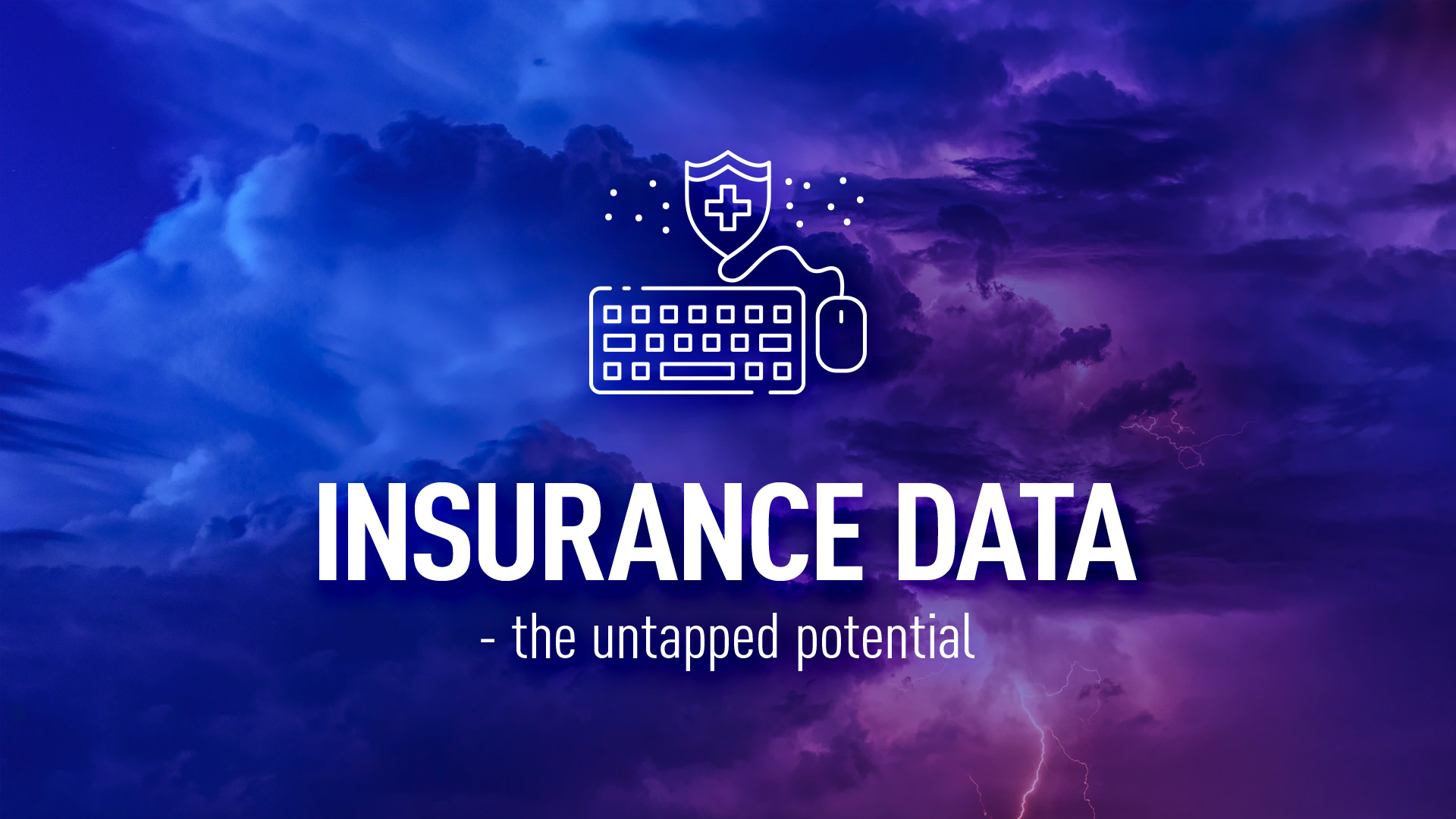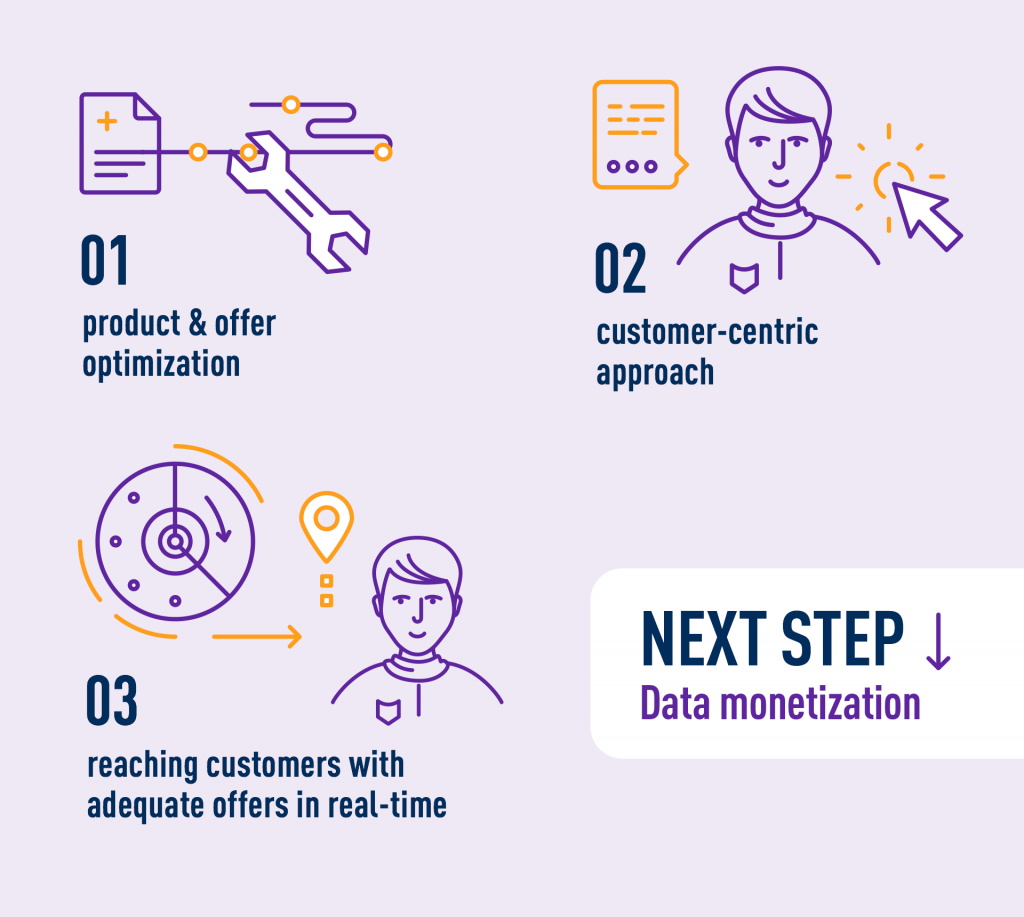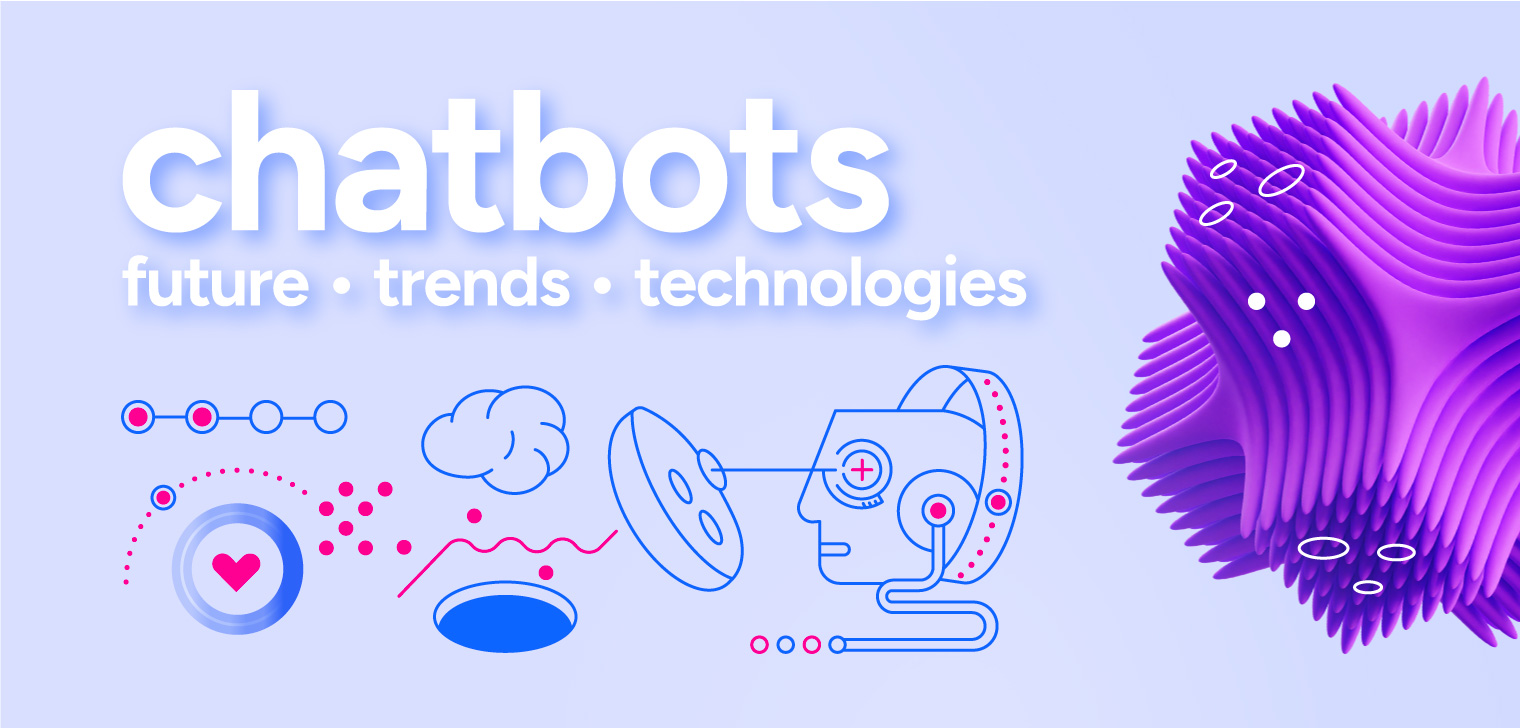Insights
- category:
Insurance data – the untapped potential

Considering digital natives’ expectations during strategical planning, including personalized products in offers, consistent, omnichannel customer service in real-time or, on the other hand, choosing a path leading to business failure – this is the choice that any company, that focus on insurance data monetization, faces in the era of the digital economy.
Digitization is the engine of change, revising everything from consumers’ behaviour and expectations to business models. By changing the rules of market competition, it imposes on entrepreneurs the need to adopt an attitude of openness and flexibility. Digitization has its obvious threats like, for example, Internet safety and privacy problems, but most of all it opens up a range of new opportunities and huge business potential.
Raw insurance data is not enough
Data collected and processed by a company is a resource that can ensure that it retains its market position and protects its revenues. Moreover, it opens up new sources of revenue. And the insurance sector is extremely rich in data.
Whatever has been said about Big Data, it is not worth much in its raw form. Only processed and analysed data has business value. Without proper technological background, knowledge and analytical experience the adaptation of such data for business use may prove difficult. But don’t let yourself be discouraged, as the results of such an investment may exceed your expectations.
New customers’ expectations shape new business models
In the modern economy, value chains in various industries are permeating, enabling the emergence of new business models, such as, for example, insurtechs. For insurance companies, they provide new methods of extracting business applications from data but also pose a competitive threat. The cooperation between insurance companies and insurtechs leads to a significant increase in offered products and easier access to new types of services. However, the emergence of insurtechs also means increased competition between insurance companies, thus leading to lower margins.
For instance, Revolut offers travel insurance that automatically activates when the insured crosses the border and is cancelled at the moment of his return. The service operates based on location data. The application retrieves information about the current location of the client, allowing the service to be activated in a timely manner but also enabling its effective promotion.
Consumer awareness is constantly growing. When planning a strategy, companies must take into account the sophisticated expectations of more and more tech-savvy customers. The generation of so-called digital natives, for whom the use of digital services comes naturally, expects omnichannel, real-time customer service. Young people expect a quick, accurate response, consistency of experience and a possibility of picking up from where they left off, be it on the same channel or a different one. A company that does not offer such services will not only fall far behind the competition, but it also won’t spark interest in young people.
One of the companies that know how to find their place in the current world of business is Lemonade. The American insurance company promises clients to pay the largest amount of compensation in the shortest possible time. It retrieves a fixed monthly payment amount, pays reinsurance and allocates the rest of the funds to pay compensation. Unused money is transferred to charity. A dedicated application makes it easier to submit compensation claims. The company’s model is based on a modern technological base that allows the analysis of much more (about 100 times more) data than traditional insurance companies. Clients’ claims are reviewed quickly and the money is transferred to the insured’s account immediately thanks to the applied technical solutions. This practice brings quick results – the company gained the trust of 250000 customers in just two years. To be able to better understand their clients and review their claims more efficiently, Lemonade has also decided to hire a world-famous behavioural economist, Professor Dan Ariely as Chief Behavioural Officer. The company, keeping their client’s experience in mind, offers a beautiful and functional design and a consistent, distinctive, modern image throughout all channels of contact with the client.
Insights from insurance data in use
There are three ways in which companies can use the knowledge gained from the insurance data they possess and process.

Historical data collected by the insurer, regarding loss ratio or insurance history, can be used to optimize products and offers. Combined with external sources providing information about, for example, the crime level in an area in which a piece of real estate is located becomes an important competitive advantage.
Certain predictions can be made based on similar, historical data. It can be a good reference point for optimizing insurance premiums. For example, the risk parameters and indicators, such as those related to construction technology, the frequency of natural disasters in a given area or the level of crime can be deduced from the data available for buildings located in the neighbourhood. Correspondingly, historical insurance data regarding payments may also be used in a similar manner.
Also, an insight into the Big Data can be used in the development of customer-centric products. An offer containing products tailored to the customers’ needs and changes occurring in their lives is a must-have nowadays. The more affordable, comprehensible and personalized your products are, the more likely you are to reach the right audience and help your consumers purchase your product. As Revolut’s example shows, using the information on the evolution of consumer needs, insurers can strive for a high degree of personalization, which in turn allows the creation of an intelligent product with an individualized, flexible duration and scope of insurance. For example, similarly to the aforementioned Revolut product, a service could be activated within an app whenever a user entered a ski slope.
The quality of the customer’s life can be improved while reducing the risk of the insurer. That’s also what the customer-centric products do. For example, reducing the risk of theft or illness allows the insurer to lower prices or increase the margin. Data from fitness trackers might be used in the process of insuring clients for life whilst at the same time promoting a healthy lifestyle for the insured. An insurance company that encourages clients to be physically active can offer more attractive contract terms in exchange. Other behaviours with a positive social impact can also be promoted. At the moment we can see several such start-ups operating on the insurance market – like Friendsurance, which promotes safe driving. Friendsurance pays the customers a bonus when they manage to avoid an accident throughout the year. Another step towards the clients is noticing that high MTPL rates for an old car standing in a car park are nonsense – something Metromile does. It offers drivers a motor insurance rate depending on the travelled distance.
Using available data, insurers can also reach clients with their offers much more efficiently. The history of the insurer’s products’ usage will allow the insurer to offer customers the most suitable offer at the best moment. Not only nearing the end of the policy, when the probability of its extension is high, and the method called “next best offer” should do the trick, but throughout the entire life cycle of client’s.
To meet the requirements of individual clients and to be able to prepare the best offers for them, micro-segmentation is necessary. Data from all customer interactions will, therefore, be an excellent material for customer segmentation. The analysis of the content of the clients’ statements and sentiment analyses can determine the communication channel preferred by a given client, as well as the ‘best time to call’. By choosing the right kind of communication with the client, the insurer will ensure maximum effectiveness, the lowest cost and return of marketing investment. What’s important, it also reduces irritation caused by receiving inadequate offers, arriving at the wrong time or through the wrong channel.
It is worth knowing that also information about current or planned special events in the client’s life, based for example on data from social media, can be a true gold-mine. It can be used to prepare an ideal offer, tailored to the client’s current life situation. Automated life-event marketing will allow the insurer to offer appropriate protection for example to a group of people publishing content on social media, from which it can be assumed that their family has just grown.
What’s next?
When an insurer
Data monetization - combining and processing data from various sources without sharing it to any party, enabling creating a completely new quality of service and product while maintaining absolute data security.
Unlike the sale of data, monetization of data consists of using it without sharing it with others. On the basis of Big Data exchange, an innovative product is developed in cooperation with partners from various industries, which in turn leads to gaining a new revenue stream.
Exchanging insurance data as a new model of cooperation
Establishing, based on a secure data exchange, cooperation with other service providers, such as telecommunications operators or banks, will allow insurers to generate additional sources of income. As a part of the API Economy (combining data within the interface economics), it is possible to securely link data from partners from various industries. As a result, knowledge about the client is fuller and can be used better, leading to more revenue for the participants.
A full customer view, created by combining data from various sources, significantly facilitates the sending of an appropriate marketing message. A complete profile, including, for example, information about purchasing power or history and purchasing characteristics, enables better product positioning and the creation of the most adequate offer. How does it work? Information about a specific event in the customer’s life, such as for instance a car purchase, originating from a partner’s sources, may trigger an insurance offer.
Trust
Due to their long presence on the market, insurance companies enjoy the trust of their customers. Consumers believe that since companies with many years of tradition are doing their data processing, it is definitely processed safely. They are, therefore, more likely to grant their marketing approvals. Thus, a niche related to the use of consents is created. Customers’ data, which the insurer possesses, can be used to optimize the offer, create client-centric services or develop the most appropriate form of communication with the client. Thanks to the consents, the insurer, cooperating with third parties, will be able to send marketing messages to joint clients via its own channels and those available to the partners.
Data monetization constitutes a new business model
It is often said that data is more valuable than gold. Companies that have large amounts of data should start treating it as an asset, no less important than capital or physical assets.
Fortunately, the data monetization is no longer perceived as equivalent to data exchange, which would probably discourage anyone from agreeing to marketing. Data processing and combining it from various sources without making it available to any of the partners allows creating a completely new quality of service and product while maintaining absolute data security. The data monetization in such a picture benefits each of the parties.
As part of the secure insurance data exchange of in the spirit of API Economy, while remaining the compliance with GDPR, TUATARA has created a platform for corporate data monetization and facilitating the generation of new revenue streams. The platform was implemented in cooperation with the telecommunications operator in Oman, Omantel. The TASIL platform enables the operator’s business clients to define hyper-specific and highly personalized advertising campaigns. The campaigns are then implemented through real-time communication channels available to the operator. The subscribers’ data is 100% secure, no parties are allowed insight at any stage. Of course, restrictions resulting from marketing approvals are also taken into account. Big Data monetization via TASIL is an additional and stable source of revenue for the operator. Importantly, it does not require the sale of data. It is also a unique marketing tool that operates in real-time for the operator’s business customers. And the end customers can be sure that they will receive a message that suits their needs at the most appropriate moment. The TASIL platform constantly proves itself in practice in Oman. If you’d like to try it yourself, read and learn more here and don’t hesitate to contact us
TASIL’s ambition is to become a link, connecting representatives of various industries, developing a model of cooperation in the spirit of API Economy.



